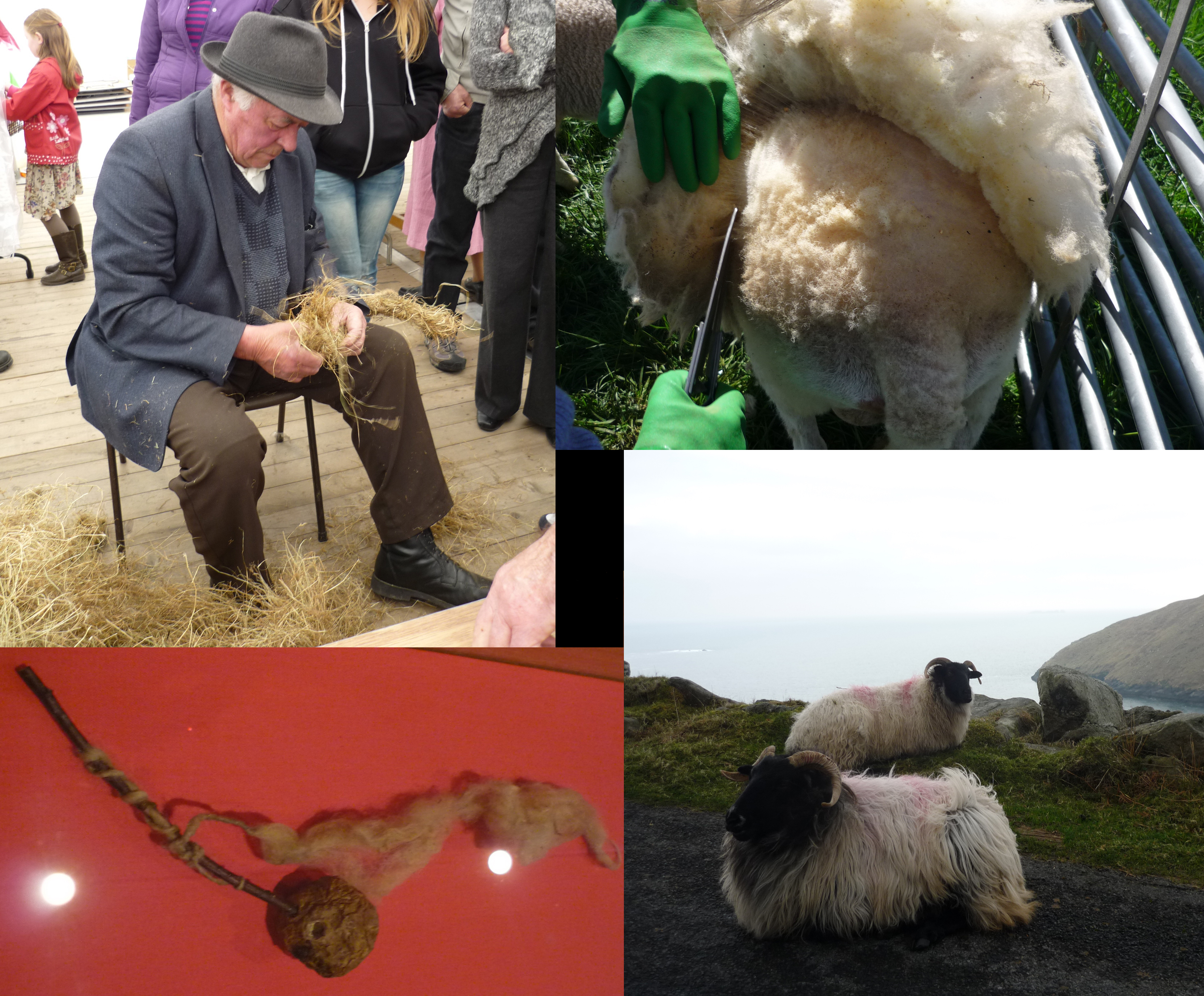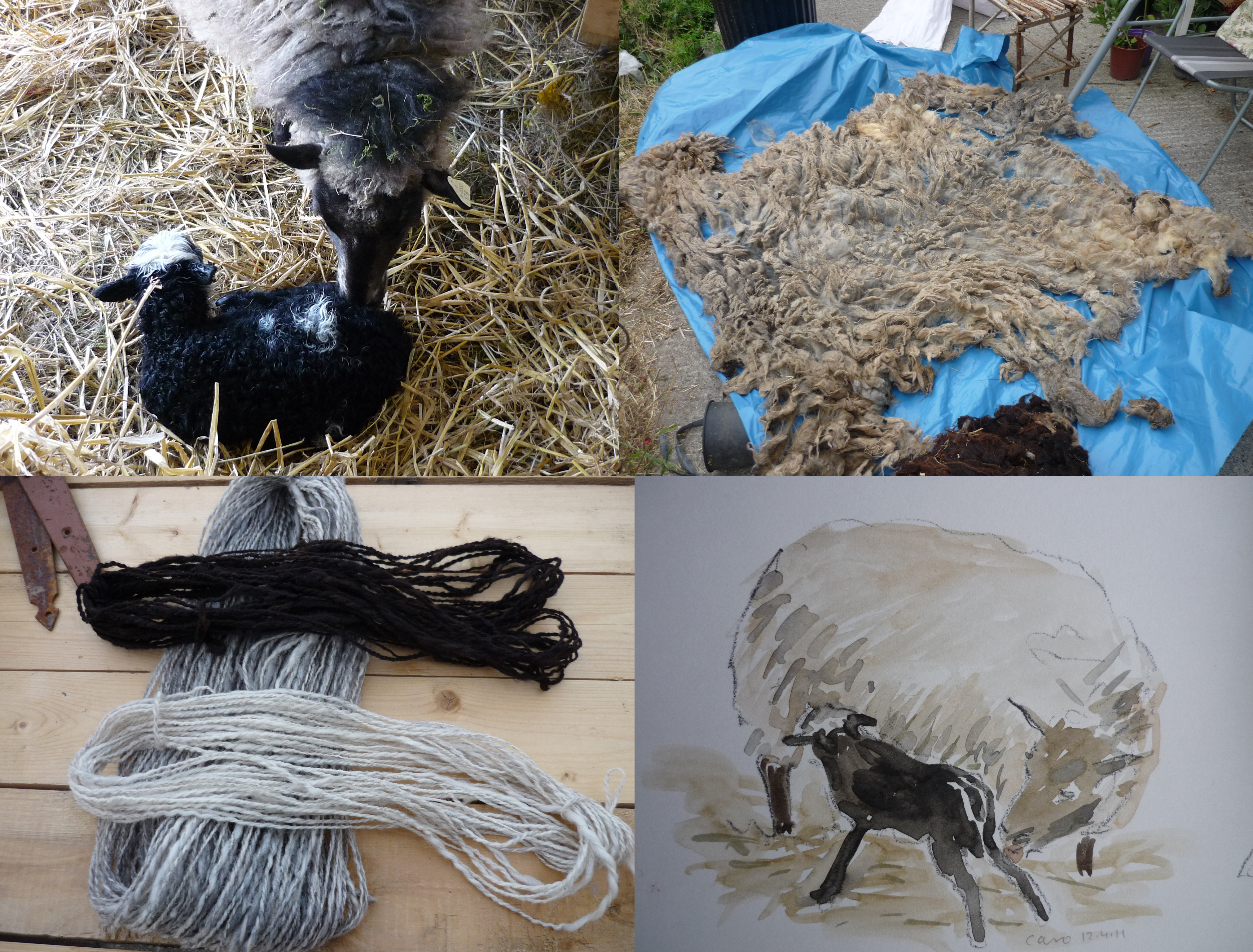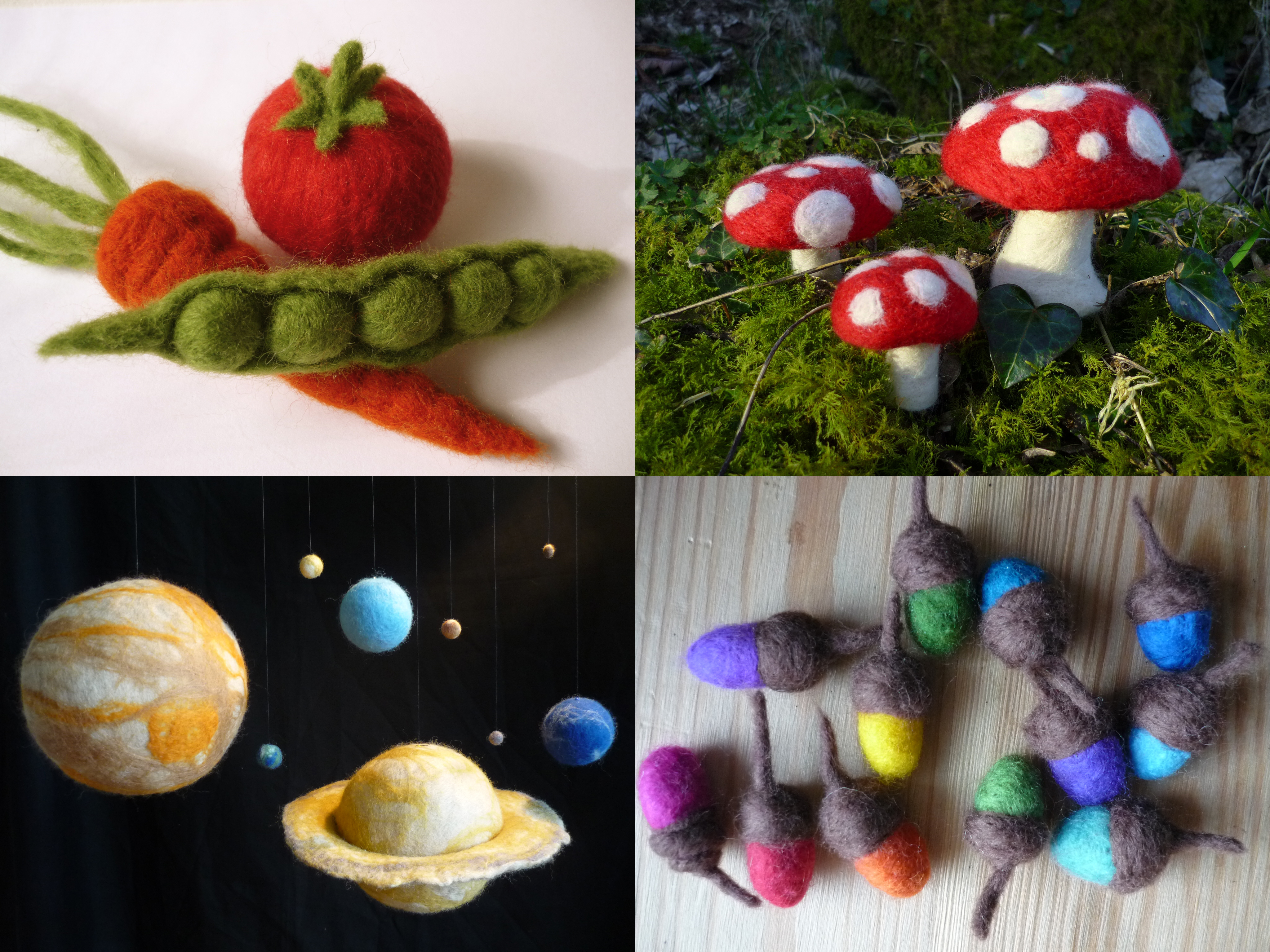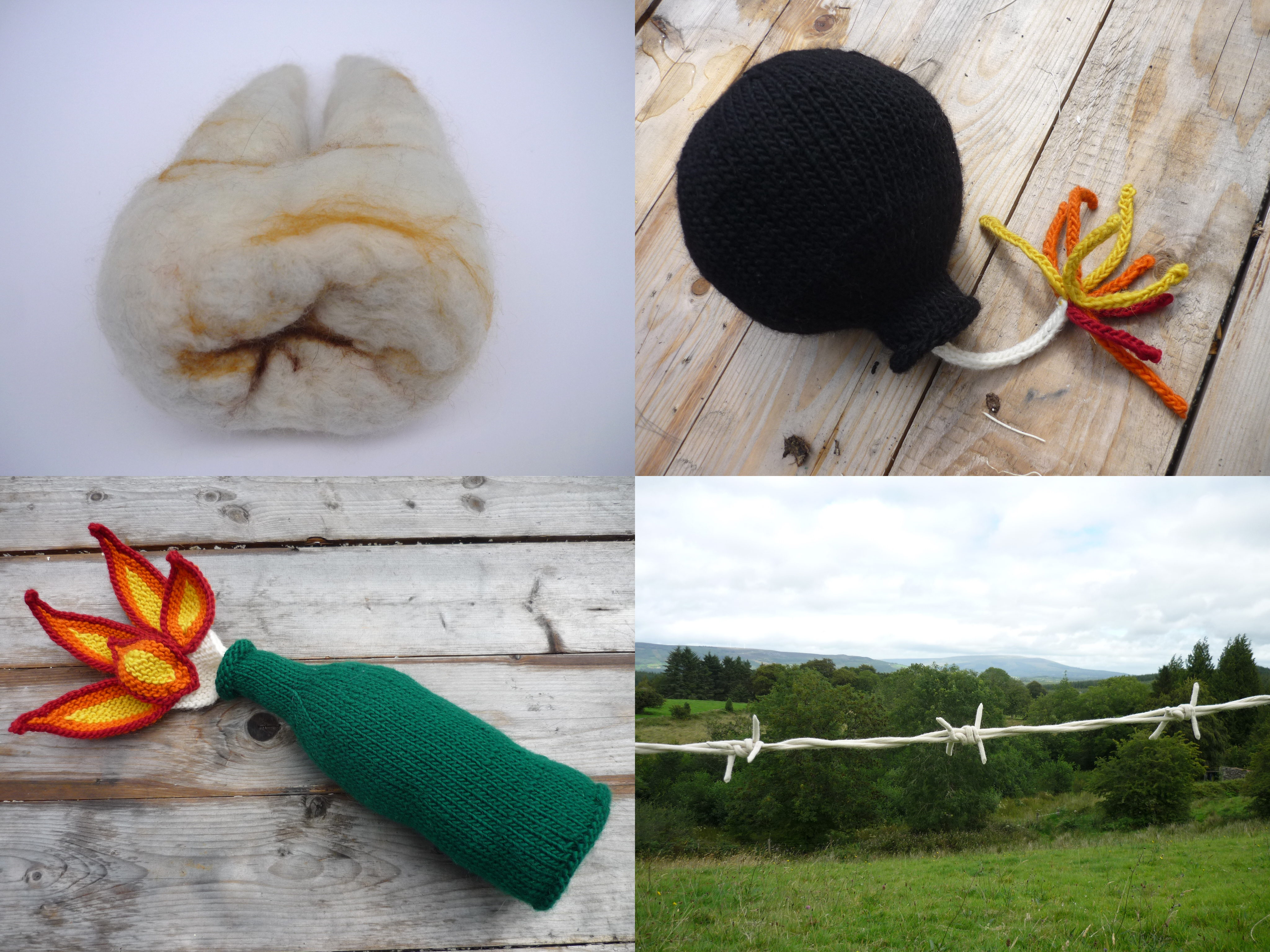Following the Prick Your Finger post, we thought it would be interesting to feature work by artists and makers who use WOOL in their practice. It is hoped that this series exploring imaginative uses of WOOL will shed more light on what WOOL means.
Today I want to introduce you to Irish artist Caroline Walshe, – whose 100% WOOL felted tooth and 100% WOOL barbed wire featured in recent contemporary Irish art shows in Galway and Roscommon. Caroline teaches a variety of wool-related crafts, including felt-making and rug-making, and she uses WOOL to develop felt-making kits and knitting patterns. Caroline also provides interesting insights into the WOOL industry in Ireland, and about learning to spin. An Snag Breac is Irish for magpie, and Caroline began her knitting career (like most skint artists) using found yarn from charity shop bargain-bins. However as time has passed, her appreciation for more sustainably produced yarns and in particular for Irish WOOL has grown, and she has sent in this essay – What I love about Wool – for your delight this Wovember. All text and images © Caroline.
What I love about Wool

Sheepythings. Clockwise from top left: Making hay ropes for sheep at the Roscommon Lamb Festival, Shearing by hand, Co. Longford, Sheep in Achill Island, Potato and stick drop spindle at the National Museum of Country Life, Castlebar.
I could mention all sorts of amazing properties about wool that I love – its ability to hold its shape in knitting, its thermal properties, its lack of static, its elasticity and its ability to felt and magically change from being a heap of loose individual fibres into a sculptural object, a thick flat blanket, or a vessel. However there is a certain something about wool for me that goes beyond all of these individual qualities that I cannot seem to describe, but which I know when I hold it in my hands; working with wool also includes a larger sense for me of caring about material in general.
I realized the importance of material to me when in college, studying sculpture. The materials I used were and still are important to me not just within art but within all areas of my life – be that my studio practice, my craft business, making furniture for my house, knitting clothes for myself, making puppetry or making dinner.
Material means something to me beyond the way something looks and behaves; it is connected to wider meanings concerning resource management and sustainability. For example, when I look at an acrylic blanket, I know the yarn used in it came from a chemical factory, extruding polymers extracted from non-renewable fossil fuels through a highly specialized process which I could never repeat at home. I am aware it cannot be thrown on the compost and is highly unlikely to ever rot. This quality of “lasting a lot longer than we do” is often cited as a good reason to buy acrylic yarn; to me the exact opposite is true; I am not going to fool myself into thinking all my knitted projects have a timeless beauty that will last forever; bloody hell, LET IT ROT! Additionally, man-made fibres are extracted using high amounts of energy – As much as 3 times that of wool.*
In contrast, when I see a wool blanket, I know where it too has come from – and I know this in a much more personal way, through my own experiences of being a spinner and working every day with wool. The path from sheep to blanket is much more transparent, much more tangible, and less abhorrent to me. Solar energy converted into pasture-land, in turn converted into protein fibres by sheep, then cleaned, carded and spun into yarn by a factory is a process which I can understand; a process that is renewable, sustainable and bio-degradable. Furthermore, this wool blanket can be put onto my compost heap at the end of its useful life, and its protein fibres will add fertility to my garden.

Shetlands. Clockwise from top left: Shetland lamb, Fleece, Drawing, Finished yarn
Amongst natural fibres, wool is the closest to my heart. Perhaps the reason for this is partially cultural. In Ireland the word ‘wool’ is synonymous with the word ‘yarn’ meaning the substance you knit with. The dominance of sheep’s wool amongst Irish textiles meant that separate terms for ‘yarn’ and ‘wool’ weren’t necessary for the larger part of history; if you were knitting with yarn, it was made from sheep’s wool.
Sheep do well here, and the tradition of working with their wool is part of our heritage in a way that working with other animal fibres from alpacas and silkworms are not. So yes, it feels local, sustainable and environmentally sound to buy Irish wool – well, it would do, if there were more Irish wools to be had. Of the three mills producing yarn for hand-knitting in Ireland, there is only one producing yarn made from 100% Irish wool. Sadly, the others are blends.
I am not against all man-made fibres; these things have a place. They just don’t have much of a place on my yarn shelves anymore. It’s been years since I bought a ball of acrylic yarn, but I’m still using them up – mainly in knitting things for people whom I know will not hand-wash garments! It is comparatively expensive to choose wool – in my craft kit business I make some hard choices (money-wise anyway), opting for 100% wool felt and wool stuffing – but it pleases me a lot to build a business which is basically bio-degradable! The wool I use in my kits I buy in the UK, and is sourced from the UK, Scandinavia and South America. Sadly it is not possible to get the range of colours and quality fibres any closer to home.

The universe in felt – needle-felting kits. Clockwise from top left: Vegetables and Toadstools Kits, Acorns, Scale model of the Solar System Kit
For my knitting projects and patterns I have good sources of affordable wool and am lucky enough to live near a small producer of very lovely grey and white Jacob yarn. I also live close enough to travel up to Studio Donegal occasionally for some of their 2kg cones.

All the knitted weaponry we need. Clockwise from top left: Felt tooth, Bomb, Felt barbed wire, Molotov Cocktail
All this can be difficult to explain to people. It involves seeing the consequences that result from the manufacture of an object, and the full story behind it when you look at it, which includes situating it in its cultural, environmental and historical context. Seeing objects in this way means seeing the factory behind a ball of acrylic yarn or the beautiful Shetland sheep belonging to your neighbour who gave you the wool to produce your own yarn. You can’t fit all that on a ball-band. There is a rich depth to using wool when you begin to see it this way.
I see myself taking more and more steps towards sustainability – I am by no means a bastion of sustainable living, but little by little I make more changes towards having a smaller footprint on this planet. And in this country, part of that plan means buying more wool, supporting more small producers, and spinners of Irish wools.

More felt. Clockwise from top left: Felt sculpture & Fox, Nest and Sheep Kits.
In conjunction with this post, Caroline will be hosting a WOVEMBER GIVEAWAY on her own blog, over at ansnagbreac.blogspot.com. Head over there right now for a chance to win one of her 100% WOOL needlefelting kits.
*Ref: LCA: New Zealand Merino Wool Total Energy Use, Andrew Barber and Glenys Pellow